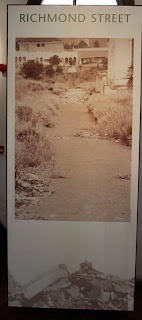It
is funny how perspective changes with context.
Halfway
through the semester I started feeling really comfortable taking the train. I
would sometimes prefer it to the minibus because the station was close and for
the same price I might get a seat that was not cramped or rickety. In addition,
I got to pass by this building with cool graffiti on its side. It became
something that I got used to seeing. Then, near the end of the semester I
noticed that the graffiti was not there anymore; someone had painted over it.

This
reminded me of District 6 and what we’d learned way back in the beginning of
the semester about forced removal of people from their homes. At the District 6
museum, Joe Schaffers showed us a photograph of a street before and after these forced
removals. The “before” photograph showed life: people walking up and down the
street, talking and carrying parcels. There were buildings and laundry hanging
and it really looked like a neighborhood. The “after” photograph showed tall
weeds and grass surrounding a single building in the distance, everything that
was had been demolished and cleared. I wondered at how easy it was for someone
to paint over the graffiti and how easy it was for someone to clear a district.
How much of our lives have been trimmed and manipulated? Textbooks, for sure,
are neatly stitched and designed to cover up certain things and illuminate
others. Our opinions, even, are never truly objective if we want it to be.


Richmond Street in District 6 before and after the Group Areas Act declare this a "White Only Area"
Another
funny incident on the train: I ran into a friend from the Human Rights Weekend
and I noticed that he was wearing a beaded bracelet. The bracelet looked like
one I had also gotten from Sonke Gender Justice Network that was part of a
pair: its beads are orange and green and one part spells “I have tested” and
the other spells “I know”. It is supposed to raise awareness for HIV testing
and address the stigma surrounding AIDS, the message meanly simply that the
person wearing the bracelet has taken the initiative to be proactive in their
health and has gotten tested for HIV. I asked him if he got the bracelet from
the Sonke organization and he said that he did not, a friend gave it to him.
He
then started talking about how much he loved it and how beautiful the message
“I know” was. He did not have the other bracelet of the pair. I was intrigued
listening to his interpretation of the bracelet as something deep and profound,
as a message meaning something along the lines of “I know who I am”. The
beauty, he said, was that it was up to you to determine what it is you or I
“know” and I had to smile at that because it is a beautiful message. I did not
see the need to correct him because his interpretation seemed just as
legitimate as mine was. It may not have been the intended message, but that
hardly matters when you go about your daily life: you see things as you want to
them.
We
keep talking about how important it is to share our stories and listen to other
people’s stories, and how critical it is that we not silence each other and
especially not people who have been chronically silenced. But I think sometimes
that we do not always know we are silencing. And does knowing a thing’s past
make it any less beautiful?




No comments:
Post a Comment